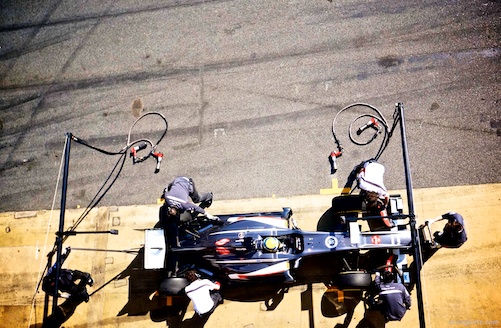ABC’s of Formula One
In Mexico, Formula One may be a recent topic. It’s just a few years ago that we are again represented by two young drivers in the pinnacle of motorsport: Esteban Gutiérrez and Sergio Pérez have put the sport back in the mouth of the fans.
Even though there was a certain interest in F1 racing, many new fans have born who identify themselves with Esteban’s image and philosophy and who are just beginning to learn the sport and its terminology.
For that reason, for you - who have recently became a fan of this sport - and also for you, the knowledgeable fan, we have prepared a compilation of the terms that are most used during a race. We hope you’ll find something here that you didn’t know before.

- ·
Aerodynamics.- The air flow interacting with the car. The air acts upon the wings and the floor to create a low pressure zone, providing the car with enormous grip. But, it can also make it slower, and for that reason the engineers work to find the optimal balance for the car. - ·
Ballast.- The minimum weight for a F1 car is 605kg., including the driver. The ballast is a metal piece that is placed on strategic places of the car to compensate any difference. It also helps the driving by maintaining the center of gravity. - ·
Marshal.- An officer in charge of safety during the race. Their duties are to watch for the spectators, the drivers, to help remove damaged cars or those that end their race on the side of the track with a failure. - ·
DRS.- Also known as adjustable wing, the DRS or Drag Reduction System allows the driver to manually adjust the wing to one of two given positions. This system’s availability is controlled electronically and can be used any time during the practice and qualifying sessions unless the car is fitted with wet tires. However, during a race, it can only be activated when the driver is less than one second behind another car and on specific zones of the track. The system disengages once the driver applies the brakes. Working together with the KERS system, the DRS is designed to allow overtaking.

- ·
Brakes.- Yes, we all know what brakes are, but an interesting fact about them is that they reach up to 1,000ºC in a Formula One car, and that is why sometimes we can see them glowing with a bright red color. For this reason, they need special air ducts that help lower the heat but not under 500ºC as the brakes won’t work at full capacity under that temperature. -
G-Force.- A physical force that is equal to one unit of gravity that is multiplied during sudden changes in speed or direction. Race drivers endure great G forces when taking a corner, as well as under acceleration and braking. - ·
KERS.- (Kinetic Energy Recovery Systems) When a car brakes, ‘kinetic’ energy is lost. This energy can be stored and used to boost the car. The driver has access to this additional power during short periods every lap and it is activated through a button on the steering wheel. - ·
Paddock.- It’s the area behind the pits where the teams keep their transports and install their hospitality areas. Normally the general public is not allowed here. - ·
Pits.- This area is separated from the track by a wall and it is the place where the cars enter to change the tires. - ·
Pole Position.- The first place on the starting grid of a race, which is earned by the driver who sets the fastest lap in qualifying.
We hope this info will help you to not get lost while watching a live race. And for you who have been Formula One fans for a while, what other terms do you think we should include in this list?
Sources: http://www.formula1.com/inside_f1/glossary.html http://news.bbc.co.uk/sport2/hi/motorsport/formula_one/8288330.stm









Esteban,
All the best for the rest of the season – we hope your first points are coming soon!
You don’t need to add any more terms to this point; just link to our blog, explaining F1 to new fans: http://theparadelap.wordpress.com/
Matthew